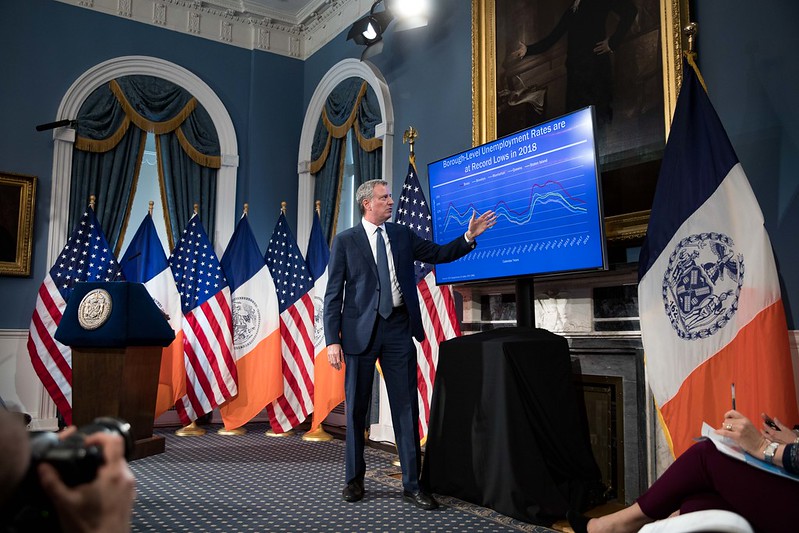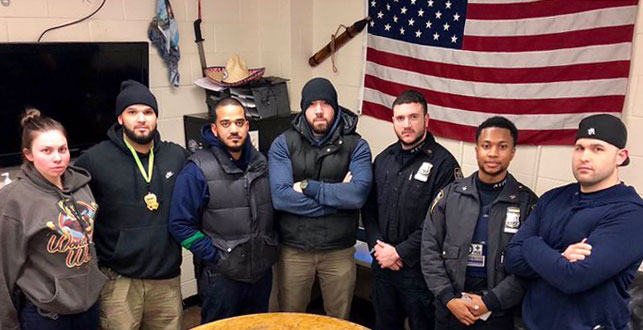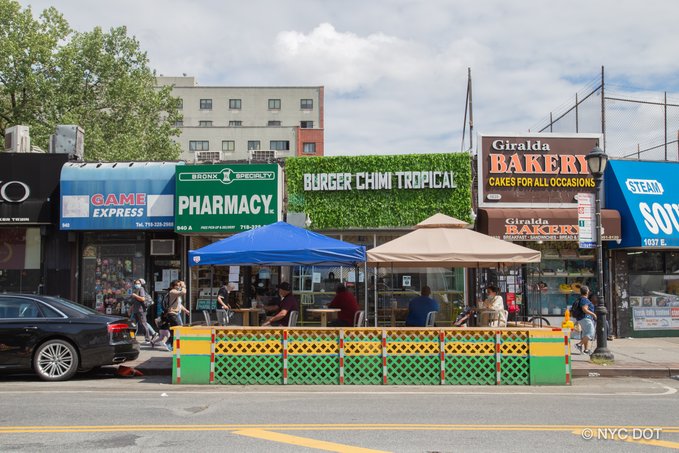New York Should Borrow to Plug Covid Budget Holes, But Not from Private Investors

Mayor de Blasio at a budget presentation (photo: Benjamin Kanter/Mayor's Office)
New York City Mayor Bill de Blasio and City Council Speaker Corey Johnson are aggressively lobbying the state Legislature to authorize the City of New York to borrow billions of dollars from private financial markets by selling municipal bonds through the Transitional Finance Authority.
Governor Andrew Cuomo also recently announced that if the federal government does not step up with stimulus money for New York, he is also open to borrowing money for our state.
Unfortunately, most people stop paying attention once they hear any financial jargon; the private investors want to keep it that way. In fact, they want the public to think that they are generously swooping in to save thousands of essential government jobs.
This is wholly false, and in bailing out our city and state we must resist borrowing from Wall Street and private investors as much as possible.
Taking private money will make the ultra wealthy even wealthier as, over the next 30 years, they collect hundreds of millions in interest from our city and state revenues. Most of their capital gains won’t even be taxed. New York’s economy will inevitably bounce back, and the 1% will continue to enrich themselves during a global crisis.
An alternative, more responsible route is to borrow from The Federal Reserve (the Fed). It is openly allowing the city to tap into their vast public resources with a simple “Add to Cart” mouse click.
For the first time in history, the Fed has created the Municipal Liquidity Facility (MLF), a new pot of money designed for unprecedented times such to attract borrowers and spark economic reinvestment in communities. The MTA, for example, just secured $451 million in early August at a 1.92% rate, almost 1 point more competitive (or roughly $12 million) than borrowing from private banks.
Consider this: the Fed is our currency issuer, and it never runs out of money. It is the world’s largest public bank, and it is not lending money in order to profit from natural catastrophes.
Borrowing from the MLF is more like borrowing from a family member with a magical money tree in their backyard -- we don’t really have to worry too much about paying them back on time. Moreover, “debt” to the Fed is not the same. The Fed will never come down on New York to bankrupt us, privatize public services, or negatively impact our credit ratings because their deficit ultimately adds real value to our communities.
Conversely, if New York City opts for private investors and faces another economic downturn in ten years, they will still come to collect, and possibly force us to privatize more public goods to fulfill our debt.
Opponents of this route, like Wall Street underwriters and investment bankers, will continue telling the city the Fed’s terms and rates are not as competitive. But this is thoroughly dispelled by cases like the MTA's, so what’s really preventing this obvious path back to economic solvency?
Corporate Democrats are unwilling to draw the line against the rich. Being self-anointed managers of corporate power has narrowed their logic and imaginative capacities. They resist new taxes and public money, two obvious solutions during this economic downturn, because their campaign donors and potential future employers -- maybe Citigroup or Goldman Sachs -- will be cut out of the deal if we turn to the Fed.
Now is precisely the time to take full advantage of the Fed’s willingness to open up its lending facility to local governments. Leaving new money behind is reckless and irresponsible. It is money we need to make our teachers and kids safe in school, keep our public transit system solvent, and avoid painful job losses. If the Fed is willing to inject new money into municipal bond markets -- at a time when state and local governments need to employ resources and people for much-needed public services and social programs -- we have a moral obligation to take it.
***
Assemblymember Ron Kim represents parts of Queens. On Twitter @rontkim.
***
Have an op-ed idea or submission for Gotham Gazette? Email This email address is being protected from spambots. You need JavaScript enabled to view it.
Time to Say Goodbye to NYPD Buy and Busts

NYPD officers (photo: @NYPDnews)
The protests following George Floyd’s murder have amplified two different, yet intertwined demands: to hold police officers accountable and to defund the police. In New York City, the NYPD’s continued use of predatory “buy and bust” operations, which target poor people of color and are conducted by detectives with long misconduct histories, exemplifies the imperative to divert funds away from policing to public health services.
As a public defender, I have handled dozens of these “buy and bust” cases. These “operations” occur daily and follow a familiar playbook. Typically, an undercover officer approaches a person in the street and attempts to purchase a “baggie” of crack or heroin. At times, the person sells the undercover drugs directly. Other times, the person directs the undercover to a street seller, hoping to receive a small tip in return. Once a buy is complete, a police “back-up” team arrests the person, whether they had completed the sale or only introduced the undercover to a seller. The whole police enterprise then proceeds to replicate the process elsewhere, often conducting six or seven “operations” per day. Public data reveals that over the past five years, these operations led to approximately 43,878 arrests — an average of 8,775 arrests a year, or 24 arrests a day.
In an unsurprising pattern for the NYPD, these operations target people of color. NYPD data reveals that between 2015-2019, 87% of people arrested in these operations were Black or Latino, a total of 38,290 arrests. Through these operations, New York City arrests, jails, and punishes poor people of color, some of whom are struggling with substance use disorder. Often these operations intentionally target people with substance use issues, one of the most vulnerable groups of individuals in our city. Even prosecutors recognize that substance use underlies many of these arrests and thus routinely extend pleas that incorporate substance abuse treatment programs.
These predatory “buy and bust” operations epitomize a failure to recognize the ineffectiveness and harm of policing — and to shift funding accordingly. Across the country, local governments have begun treating substance use disorder as a public health epidemic. Some of the new approaches address substance use itself, such as providing methadone, clean syringes, and safe injection spaces; others address homelessness and access to alternative pain reduction treatments; and still others are preventative, providing much-needed employment opportunities, child-care, and counseling services. Yet Mayor de Blasio has chosen to continue to police and imprison Black and brown people, rather than to provide assistance and opportunities.
Drug treatment pleas, which often result from buy and bust arrests, demonstrate the harm caused by attempting to solve a public-health problem through policing and the courts. Many of the individuals who are swept in by these operations are not mentally or physically prepared to cease substance use and to engage productively in a 12- to 24-month program. Instead, they often opt to take treatment pleas because they fear the alternative — a prison sentence. As a result, relapses are common, and even with the help of dedicated, supportive, and caring program staff, clients too often end up imprisoned for long periods of time when they fail to complete their program. Moreover, treatment pleas encourage courts to leave unexamined the police’s conduct, a process slowly eroding constitutional due process protections. Thus, treatment-by-threat is far from the public health-focused approach recommended by experts, and implemented elsewhere.
Defunding buy and bust operations will free up millions of dollars that could be invested in community-based approaches. Up to ten officers participate in each operation, many of whom are detectives earning high base salaries. Moreover, many of the involved officers collect substantial overtime pay for each operation — booking and jailing six or seven people takes the officers well past the end of their shift. The financial costs associated with these operations are further inflated in the courts. Data from the Bronx Defenders indicates that in 2015-2019, buy and bust cases were pending in court for an average of 97 days, while 1,107 of those 3,201 cases (an enormous 34%) were dismissed. Throughout the litigation of these cases, city funds pay the salaries of public defenders, prosecutors, judges, and court staff — instead of funding community-based services.
Unsurprisingly, officers involved in serious and repeated misconduct are the ones often conducting these predatory buy and bust operations. Misconduct allegations, including planting and fabrication of evidence, as well as the rape of a teen woman, have dogged Narcotics officers for years. A recent analysis found that 8 of the 10 most-sued officers for misconduct were from Narcotics, the command that conducts these operations. Yet these are not just single “bad apples”: 6.9% of substantiated civilian allegations were made against Narcotics officers and involved a total of 254 different officers. No wonder, then, that prosecutors have ended up dismissing 34% of these cases in the Bronx; the prosecutors themselves do not trust Narcotics officers and the arrests they make.
Buy and bust operations do nothing to address the needs of the community or help people with substance use issues. It is a self-serving enterprise that helps dirty cops rack up overtime by targeting vulnerable people.
The mayor has so far failed to heed the calls to defund the police and hold officers accountable. The recent, insufficient cuts to the NYPD budget have all but disappeared amidst sky-rocketing overtime costs propelled by now-debunked claims, while officers with lengthy, violent misconduct records still prowl our streets. If the mayor ever chooses to begin to stand for progress and justice, defunding predatory buy and bust operations, and the bad cops who run them, can be a start.
***
Oded Oren is a Criminal Defense Attorney at The Bronx Defenders.
***
Have an op-ed idea or submission for Gotham Gazette? Email This email address is being protected from spambots. You need JavaScript enabled to view it.
Uncurb Our Enthusiasm: How the City Can Better Help Restaurants and Keep New Yorkers Moving

Outdoor dining is proving successful (photo: @NYC_DOT)
With the City’s popular Open Streets and Open Restaurants programs, the de Blasio administration has taken important steps forward to support New Yorkers during the pandemic, helping to ensure that people, not just cars, have much needed access to our streets.
Meanwhile, the success of these programs have been amplified by the continued growth of biking as a safe, socially distanced form of transportation, and by bikeshare’s ongoing expansion into the Bronx and Upper Manhattan. In New York City and elsewhere, restaurants have a long history of prospering in areas that prioritize walking, biking, and mass transit (studies show that restaurants in New York increase sales after Citi Bike stations are installed nearby, and bike lanes have shown to increase retail sales by up to 49%). This current moment is no different - if anything, the complementary nature of good street uses has never been more important.
It’s heartening to see that the city’s outdoor dining program is expected to continue into 2021 and we believe that the Department of Transportation (DOT) can make it even more effective. Specifically, DOT should develop policies addressing curbside space as part of the growing Open Streets and Open Restaurants programs that ensure all new users of our streets, whether restaurants, retail, cultural institutions, and schools can co-exist in limited space, and, most importantly, not disrupt our critical transportation system, including Citi Bike stations.
While the city’s current approach to outdoor dining approvals and regulation has come with the benefit of flexibility and speed, it has also left a dearth of guidance on how to resolve complicated and unique situations that some businesses and residents may face. Over the last few weeks, as outdoor dining has continued to thrive, and as cyclists use bikeshare more and more, there have been a few instances where these popular users of streetspace have come into unnecessary conflict with each other. Restaurants found themselves unable to take advantage of the outdoor dining program because they were told by the city that the existence of transportation infrastructure like Citi Bike docks, loading zones, or bus stops precluded their ability to participate in the program.
Combined, outdoor dining and bikeshare stations take up a small fraction of our city’s curb space: Citi Bike docking stations account for just 0.5% of curb space within the footprint of the bikeshare system’s service area. And according to Meera Joshi at Sam Schwartz Engineering, curbside dining eats up a similarly miniscule piece of the streetscape pie, occupying only 0.3% of curbspace.
Given how integral both services are to our city, and how little space they take up, the city needs to make more space available and be more creative about the footprint of outdoor dining. Specifically, the city should look to take more free parking, which currently occupies around 75% of curbside space in New York City, as a lifeline to struggling businesses and critical transportation modes like biking and buses.
Moving forward, we encourage the city to change the rules that limit outdoor dining to the spaces immediately in front of a restaurant’s building frontage. Instead, restaurants that may be currently limited or blocked from outdoor dining space due to the placement of critical infrastructure, should be able to access adjacent and available curbside space. We believe that this simple addition will both support our hospitality industry and keep New Yorkers moving.
The future of New York City requires our leaders to reimagine our assets, including street and curb space, in support of tools that can benefit all New Yorkers.
***
Tom Birchard is the Owner of Veselka Restaurant. Danny Harris is Executive Director of Transportation Alternatives. On Twitter @veselkanyc and @DannyHarris_TA.
***
Have an op-ed idea or submission for Gotham Gazette? Email This email address is being protected from spambots. You need JavaScript enabled to view it.




